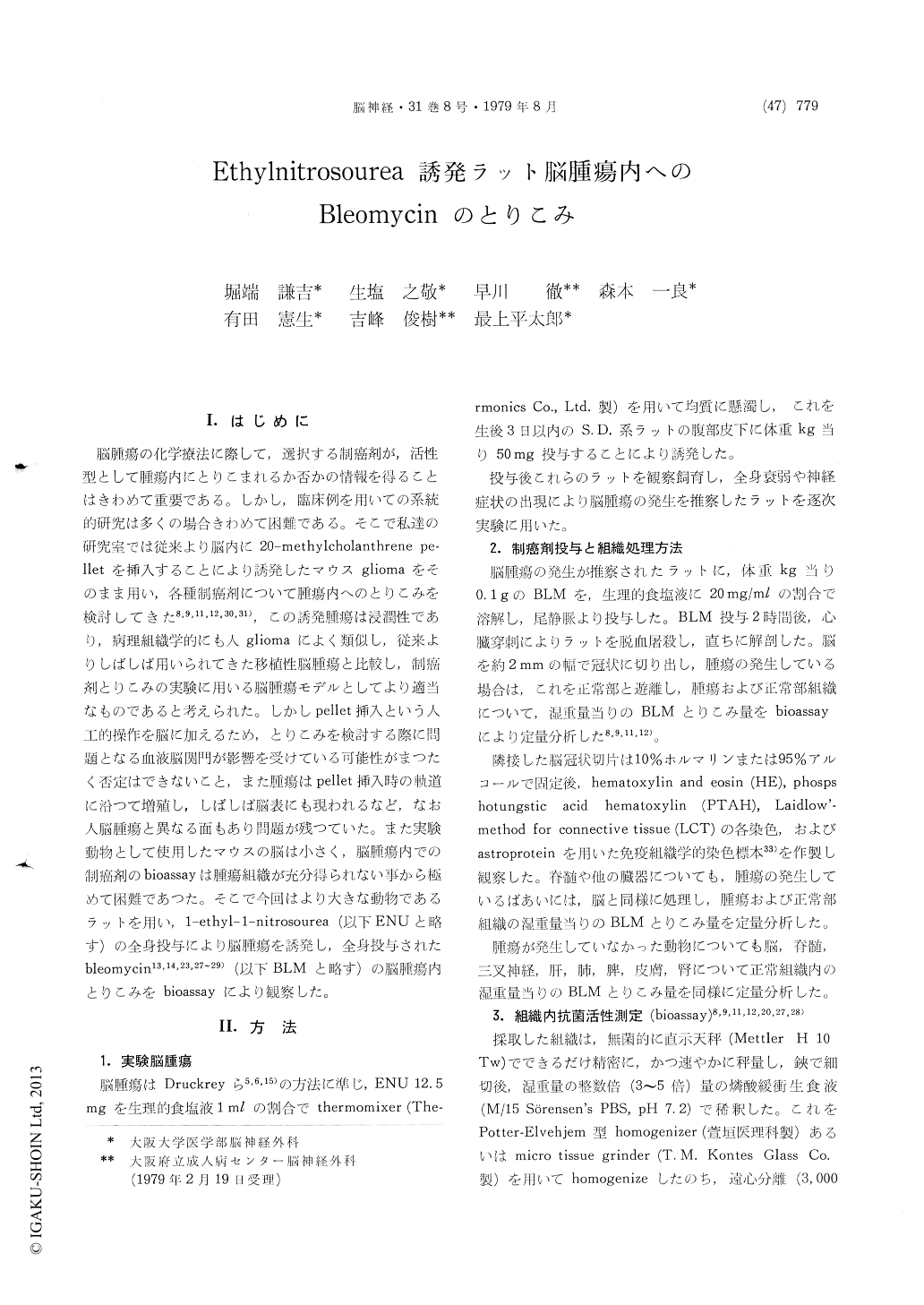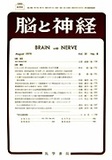Japanese
English
- 有料閲覧
- Abstract 文献概要
- 1ページ目 Look Inside
I.はじめに
脳腫瘍の化学療法に際して,選択する制癌剤が,活性型として腫瘍内にとりこまれるか否かの情報を得ることはきわめて重要である。しかし,臨床例を用いての系統的研究は多くの場合きわめて困難である。そこで私達の研究室では従来より脳内に20—methylcholanthrene pe—lletを挿入することにより誘発したマウスgliomaをそのまま用い,各種制筋剤について腫瘍内へのとりこみを検討してきた8,9,11,12,30,31),この誘発腫瘍は浸潤性であり,病理組織学的にも人gliomaによく類似し,従来よりしばしば用いられてきた移植性脳腫瘍と比較し,制癌剤とりこみの実験に用いる脳腫瘍モデルとしてより適当なものであると考えられた。しかしpellet挿入という人工的操作を脳に加えるため,とりこみを検討する際に問題となる血液脳関門が影響を受けている可能性がまつたく否定はできないこと,また腫瘍はpellet挿入時の軌道に沿つて増殖し,しばしば脳表にも現われるなど,なお人脳腫瘍と異なる面もあり問題が残つていた。また実験動物として使用したマウスの脳は小さく,脳腫瘍内での制癌剤のbioassayは腫瘍組織が充分得られない事から極めて困難であつた。そこで今回はより大きな動物であるラットを用い,1—ethyl−1—nitrosourea (以下ENUと略す)の全身投与により脳腫瘍を誘発し,全身投与されたbleomycinl3,14,23,27〜29)(以下BLMと略す)の脳腫瘍内とりこみをbioassayにより観察した。
The uptake of systemically administered bleo-mycin by 1-ethyl-l-nitrosourea-induced tumors of the central nervous system in rats were assayed by the paper disc method using B. subtilis PCI 219 IMC spores as the test organism.
Brain tumors were induced by subcutaneous in-jection of 1-ethyl-l-nitrosourea in S. D. rats within 3 days after birth at a dose of 50 mg per kg of body weight.
Forty-three symptomatic animals were admini-stered with bleomycin at a dose of 0.1 g per kg of body weight via the tail vein, and sacrificed by exsanguination two hours later. All animals were autopsied, and the induced tumors and normal tissues were removed from various organs for bio-assay of bleomycin. The adjacent tissues were fix edin either 10% formalin or 95% alcohol, and histo-logic sections were stained with hematoxylin and eosin, phos photungstic acid hematoxylin, Laidlow's method for connective tissue and immunofiuoresc-ence or immunoperoxidase using antiserum toAstroprotein.
Active form of bleomycin was detected in all induced tumors which consisted of 11 gliomas of the brain. 11 gliomas of the spinal cord, 14 schwannomas of the trigeminal nerve and 4 pitui-tary adenomas ; they were induced 8.0±0.5 (mean ±SEM), 8.1±0.6, 7.3±1.0 and 14.9±1.3 months after the subcutaneous administration of 1-ethyl-1-nitrosourea, respectively.
The average levels of bleomycin in the tumors were 7.69±2.84 mcg/g in gliomas of the brain, 7.10±3.15 mcg/g in gliomas of the spinal cord, 5.40 ±1.41 mcg/g in schwannomas of the trigeminal nerve and 4.83±1.05mcg/g in pituitary adenomas.
The tumor-plasma concentration ratio of bleo-mycin was 0.13±0.05 in gliomas of the brain, 0.27 ±0.12 in gliomas of the spinal cord, 0.23±0.05 inschwannomas of the trigeminal nerve and 0.21±0.08 in pituitary adenomas. The uptake of bleo-mycin by the normal brain and spinal cord was nill or trace. The average levels of bleomycin in normal tissues of various organs were: trigeminal nerve, 2.01±0.47 mcg/g; pituitary gland, 0.20±0.16 mcg/g; liver, 0.61±0.46 mcg/g; lung, 7.20±1.07 mcg/g ; spleen, 0.64±0.56 mcg/g; skin, 11.30±1.79 mcg/g and kidney, 37.01±6.46 mcg/g.
These findings are similar to those seen in our previous studies concerning the uptake of bleo-mycin by human brain tumors, and suggests that the 1-ethyl-1-nitrosourea-induced brain tumor in rats is an useful experimental model for the study of drug distribution in brain tumors.

Copyright © 1979, Igaku-Shoin Ltd. All rights reserved.


